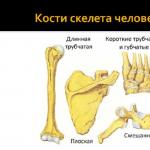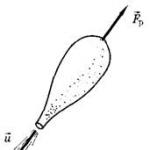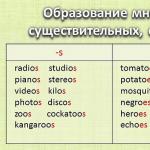Any body can be influenced by other bodies surrounding it, as a result of which the state of motion (rest) of the observed body can change. At the same time, such impacts can be compensated (balanced) and not cause such changes. When they say that the actions of two or more bodies compensate each other, it means that the result of their joint action is the same as if these bodies did not exist at all. If the influence of other bodies on the body is compensated, then relative to the Earth the body is either at rest, or moves in a straight line and evenly.
Thus, we come to one of the basic laws of mechanics, which is called Newton's first law.
1st Newton's Law (Law of Inertia)
There are such reference systems in which a translationally moving body is in a state of rest or uniform rectilinear motion (motion by inertia) until influences from other bodies take it out of this state.
In relation to the above, a change in the speed of a body (i.e. acceleration) is always caused by the action of any other bodies on this body.
1st Newton's law is fulfilled only in inertial frames of reference.
Definition
Reference frames relative to which the body, not experiencing the impact of other bodies, rests or moves uniformly and rectilinearly, are called inertial.
It is possible to establish whether a given frame of reference is inertial only by experience. In most cases, it is possible to consider inertial reference systems associated with the Earth or with reference bodies that move uniformly and rectilinearly relative to the earth's surface.
Figure 1. Inertial reference frames
At present, it has been experimentally confirmed that the heliocentric reference system associated with the center of the Sun and three "fixed" stars is practically inertial.
Any other frame of reference moving uniformly and rectilinearly relative to inertial is itself inertial.
Galileo established that no mechanical experiments performed inside an inertial frame of reference could establish whether this frame is at rest or if it moves uniformly and rectilinearly. This statement is called Galileo's principle of relativity, or the mechanical principle of relativity.
This principle was later developed by A. Einstein and is one of the postulates of the special theory of relativity. IFRs play an extremely important role in physics, since, according to Einstein's principle of relativity, the mathematical expression of any law of physics has the same form in each IFR.
If the reference body moves with acceleration, then the reference frame associated with it is non-inertial, and Newton's first law in it is unjustified.
The property of bodies to preserve their state in time (speed of movement, direction of movement, state of rest, etc.) is called inertia. The very phenomenon of conservation of speed by a moving body in the absence of external influences is called inertia.

Figure 2. Manifestations of inertia in the bus at the start of movement and braking
We often meet with the manifestation of inertness of bodies in everyday life. With a sharp acceleration of the bus, the passengers in it lean back (Fig. 2, a), and with a sharp braking of the bus, they lean forward (Fig. 2, b), and when the bus turns to the right - to its left wall. At high acceleration of an airplane taking off, the body of the pilot, trying to maintain its original state of rest, is pressed against the seat.
The inertia of the bodies is clearly manifested with a sharp change in the accelerations of the bodies of the system, when the inertial frame of reference is replaced by the non-inertial one, and vice versa.

The inertness of a body is usually characterized by its mass (inert mass).
The force acting on the body from the side of the non-inertial frame of reference is called the force of inertia
If several forces act simultaneously on a body in a non-inertial frame of reference, some of which are "ordinary" forces, and others are inertial, then the body will experience one resultant force, which is the vector sum of all forces acting on it. This net force is not inertial force. The force of inertia is only a component of the resulting force.
If the stick, suspended on two thin threads, is slowly pulled by the cord attached to its center, then:
- the wand will break;
- the cord will break;
- one of the threads will break;
- any option is possible, depending on the applied force

Figure 4
The force is applied to the middle of the stick, at the point where the cord hangs. Since, according to Newton's 1 law, every body is inert, a part of the rod at the point of suspension of the cord will move under the action of the applied force, and other parts of the rod, on which the force does not act, will remain at rest. Therefore, the stick will break at the suspension point.
Answer. The correct answer is 1.
A man is pulling two tied sleighs, applying force at an angle of 300 to the horizon. Find this force if the sled is known to move evenly. The weight of the sleigh is 40 kg. Friction coefficient 0.3.
$ t_1 $ = $ t_2 $ = $ m $ = 40 kg
$ (\ mathbf \ mu) $ = 0.3
$ (\ mathbf \ alpha) $ = $ 30 ^ (\ circ) $
$ g $ = 9.8 m / s2

Figure 5
Since the sleigh moves at a constant speed, then, according to Newton's first law, the sum of the forces acting on the sleigh is zero. Let us write Newton's first law for each body directly in projection on the axis, and add Coulomb's dry friction law for the sleigh:
OX axis OY axis
\ [\ left \ (\ begin (array) (c) T-F_ (tr1) = 0 \\ F_ (tr1) = \ mu N_1 \\ F_ (tr2) = \ mu N_2 \\ F (cos \ alpha - \) F_ (tr2) -T = 0 \ end (array) \ right. \ Left \ (\ begin (array) (c) N_1-mg = 0 \\ N_2 + F (sin \ alpha \) -mg = 0 \ end (array) \ right. \]
$ F = \ frac (2 \ mu mg) ((cos \ alpha \) + \ mu (sin \ alpha \)) = \ \ frac (2 \ cdot 0.3 \ cdot 40 \ cdot 9.8) ((cos 30 () ^ \ circ \) +0.3 \ cdot (sin 30 () ^ \ circ \)) = 231.5 \ H $
The first law of mechanics, or the law of inertia ( inertia- this is the property of bodies to maintain their speed in the absence of other bodies acting on it ), as it is often called, was established by Galileo. But Newton gave a strict formulation of this law and included it among the basic laws of mechanics. The law of inertia applies to the simplest case of motion - the motion of a body, which is not influenced by other bodies. Such bodies are called free bodies.
It is impossible to answer the question of how free bodies move without referring to experience. However, it is impossible to stage a single experiment that would show in its pure form how a body that does not interact with anything moves, since there are no such bodies. How to be?
There is only one way out. It is necessary to create conditions for the body under which the influence of external influences can be made smaller and smaller, and observe where this leads. You can, for example, observe the movement of a smooth stone on a horizontal surface after a certain speed has been imparted to it. (The attraction of a stone to the ground is balanced by the action of the surface on which it rests, and only friction affects the speed of its movement.) It is easy to find that the smoother the surface, the slower the speed of the stone will decrease. On smooth ice, the stone slides for a very long time, without noticeably changing its speed. Friction can be reduced to a minimum by using an air cushion - jets of air that support the body above a solid surface along which movement occurs. This principle is used in water transport (hovercraft). Based on such observations, we can conclude: if the surface were ideally smooth, then in the absence of air resistance (in vacuum), the stone would not change its speed at all. It was this conclusion that Galileo first came to.
On the other hand, it is easy to see that when the speed of a body changes, the effect of other bodies on it is always detected. Hence, we can conclude that a body that is sufficiently distant from other bodies and for this reason does not interact with them, moves at a constant speed.
The motion is relative, therefore it makes sense to talk only about the motion of the body in relation to the frame of reference associated with another body. The question immediately arises: will a free body move at a constant speed in relation to any other body? The answer, of course, is no. So, if in relation to the Earth the free body moves rectilinearly and uniformly, then in relation to the rotating carousel the body will certainly not move in this way.
Observing the movements of bodies and thinking about the nature of these movements lead us to the conclusion that free bodies move at a constant speed, at least in relation to certain bodies and related frames of reference. For example, in relation to the Earth. This is the main content of the law of inertia.
therefore Newton's first law can be formulated like this:
there are such frames of reference relative to which the body (material point), in the absence of external influences on it (or with their mutual compensation), maintains a state of rest or uniform rectilinear motion.
Inertial frame of reference
Newton's first law asserts (this can be verified with varying degrees of accuracy by experience) that inertial systems exist in reality. This law of mechanics places inertial reference frames in a special, privileged position.
Reference systems, in which Newton's first law is satisfied, are called inertial.
Inertial frames of reference- these are systems relative to which a material point, in the absence of external influences or their mutual compensation, rests or moves uniformly and rectilinearly.
There are an infinite number of inertial systems. The counting system associated with a train traveling at a constant speed along a straight section of track is also an inertial system (approximately), like a system associated with the Earth. All inertial reference frames form a class of systems that move uniformly and rectilinearly relative to each other. The accelerations of any body in different inertial systems are the same.
How to establish that a given frame of reference is inertial? This can only be done empirically. Observations show that, with a very high degree of accuracy, it is possible to consider the heliocentric system as an inertial reference frame, in which the origin of coordinates is connected with the Sun, and the axes are directed to certain "fixed" stars. Reference systems rigidly connected with the Earth's surface, strictly speaking, are not inertial, since the Earth moves in an orbit around the Sun and at the same time rotates around its axis. However, when describing motions that do not have a global (i.e., universal) scale, the reference frames associated with the Earth can be considered inertial with sufficient accuracy.
Inertial reference frames are those that move uniformly and rectilinearly relative to any inertial reference frame.
Galileo found that no mechanical experiments carried out inside the inertial frame of reference, it is impossible to establish whether this system is at rest or moves uniformly and rectilinearly... This statement is called Galileo's principle of relativity or mechanical principle of relativity.
This principle was later developed by A. Einstein and is one of the postulates of the special theory of relativity. Inertial frames of reference play an extremely important role in physics, since, according to Einstein's principle of relativity, the mathematical expression of any law of physics has the same form in each inertial frame of reference. In the future, we will use only inertial systems (without mentioning this every time).
Reference frames in which Newton's first law does not hold are called non-inertial and.
Such systems include any frame of reference moving with acceleration relative to the inertial frame of reference.
In Newtonian mechanics, the laws of interaction of bodies are formulated for a class of inertial reference frames.
The behavior Foucault pendulum... This is the name of a massive ball suspended by a sufficiently long thread and performing small vibrations around the equilibrium position. If the system associated with the Earth were inertial, the swing plane of the Foucault pendulum would remain unchanged relative to the Earth. In fact, the swinging plane of the pendulum rotates due to the rotation of the Earth, and the projection of the trajectory of the pendulum onto the surface of the Earth looks like a rosette (Fig. 1). Rice. 2
Literature
- Open Physics 2.5 (http://college.ru/physics/)
- Physics: Mechanics. 10th grade: Textbook. for in-depth study of physics / M.M. Balashov, A.I. Gomonova, A.B. Dolitsky and others; Ed. G.Ya. Myakisheva. - M .: Bustard, 2002 .-- 496 p.
Any frame of reference moving with respect to the inertial frame of reference translationally, uniformly and rectilinearly is also an inertial frame of reference. Therefore, theoretically, any number of inertial reference frames can exist.
In reality, the frame of reference is always associated with some specific body, in relation to which the movement of various objects is studied. Since all real bodies move with one or another acceleration, any real frame of reference can be considered as an inertial frame of reference only with a certain degree of approximation. With a high degree of accuracy, the inertial system can be considered a heliocentric system associated with the center of mass of the solar system and with axes directed to three distant stars. Such an inertial reference system is used mainly in problems of celestial mechanics and astronautics. For the solution of most technical problems, the inertial reference system can be considered rigidly connected with the Earth.
Galileo's principle of relativity
Inertial reference frames have an important property that describes Galileo's principle of relativity:
- any mechanical phenomenon under the same initial conditions proceeds in the same way in any inertial frame of reference.
The equality of inertial frames of reference, established by the principle of relativity, is expressed in the following:
- the laws of mechanics in inertial reference frames are the same. This means that the equation describing a certain law of mechanics, being expressed in terms of the coordinates and time of any other inertial frame of reference, will have the same form;
- based on the results of mechanical experiments, it is impossible to establish whether a given frame of reference is at rest or moves uniformly and rectilinearly. Due to this, none of them can be distinguished as a predominant system, the speed of movement of which could be given an absolute meaning. Only the concept of the relative speed of movement of systems has a physical meaning, so that any system can be considered conditionally stationary, and the other - moving relative to it with a certain speed;
- the equations of mechanics are invariable with respect to coordinate transformations in the transition from one inertial reference system to another, i.e. one and the same phenomenon can be described in two different frames of reference outwardly in different ways, but the physical nature of the phenomenon remains unchanged.
Examples of problem solving
EXAMPLE 1
EXAMPLE 2
| The task | The reference system is rigidly connected to the elevator. In which of the following cases can the frame of reference be considered inertial? The elevator: a) falls freely; b) moves evenly upward; c) is moving upwards at an accelerated rate; d) moves slowly up; e) moves evenly downward. |
| Answer | a) free fall is movement with acceleration, therefore, the frame of reference associated with the elevator in this case cannot be considered inertial; b) since the elevator moves uniformly, the frame of reference can be considered inertial; |
Inertial reference frames are called such systems, relative to which all bodies that do not experience the action of forces move uniformly and rectilinearly.
If any frame of reference moves relative to the inertial frame translationally, but not rectilinearly and uniformly, but with acceleration or rotating, then such a frame cannot be inertial and the law of inertia is not fulfilled in it.
In all inertial reference frames all mechanical and physical processes proceed in exactly the same way (under the same conditions).
According to the principle of relativity, everything inertial reference frames are equal and all manifestations of the laws of physics in them look the same, and the records of these laws in different inertial reference frames have the same form.
If in an isotropic space there is at least one inertial reference frame, we come to the conclusion that there is an infinite number of such systems moving relative to each other translationally, uniformly and rectilinearly. If inertial frames of reference exist, then space is homogeneous and isotropic, and time is homogeneous.
Newton's laws and other laws of dynamics are fulfilled only in inertial reference frames.
Let's consider an example of inertial and non-inertial systems. Take the cart with two balls on it. One of them lies on a horizontal surface, and the other is suspended from a thread. First, the cart moves relative to the Earth rectilinearly and uniformly ( but). The forces acting on each ball vertically are balanced, and horizontally no forces act on the balls (the force of air resistance can be ignored).
At any speed of movement of the cart relative to the ground ( υ 1, υ 2, υ 3 etc.) the balls will be at rest relative to the cart, the main thing is that the speed is constant.
However, when the cart hits the sand embankment ( b), its speed will begin to decrease rapidly, as a result of which the cart will stop. During the braking of the carriage, both balls will set in motion - they will change their speed relative to the carriage, although they are not pushed by any forces.
In this example, the first (conditionally stationary) frame of reference is the Earth. The second frame of reference moving relative to the first is a cart. While the cart was moving uniformly and in a straight line, the balls were at rest relative to the cart, that is, the law of inertia was fulfilled. As soon as the cart began to slow down, that is, began to move with acceleration relative to the inertial (first) frame of reference, the law of inertia ceased to be fulfilled.
There is no strictly inertial frame of reference. A real frame of reference is always associated with some specific body, in relation to which various objects are studied. All real bodies move with some kind of acceleration, therefore, any real frame of reference can be considered as inertial only approximately.
Inertial system a heliocentric system associated with the center of the sun and coordinate axes directed to three distant stars is considered with a very high degree of accuracy. This system is used in problems of celestial mechanics and astronautics. In most technical problems, an inertial reference system is considered to be any system rigidly connected to the earth (or any body that rests or moves in a straight line and uniformly relative to the earth's surface).
Inertial frame of reference (ISO)- a frame of reference in which the law of inertia is valid: all free bodies (that is, those that are not acted upon by external forces or the action of these forces is compensated for) move in them rectilinearly and uniformly or rest in them.
Non-inertial frame of reference- an arbitrary frame of reference that is not inertial. Any frame of reference moving with acceleration relative to inertial is non-inertial.
Newton's first law - there are inertial frames of reference, that is, such frames of reference in which the body moves uniformly and rectilinearly if other bodies do not act on it. The main role of this law is to emphasize that in these frames of reference all accelerations acquired by bodies are the consequences of the interactions of bodies. Further description of the movement should be carried out only in inertial reference systems.
Newton's second law states that the reason for the acceleration of a body is the interaction of bodies, the characteristic of which is force. This law gives the basic equation of dynamics, which allows, in principle, to find the law of motion of a body if the forces acting on it are known. This law can be formulated as follows (Fig. 100):
the acceleration of a point body (material point) is directly proportional to the sum of the forces acting on the body, and inversely proportional to the mass of the body:

here F- the resulting force, that is, the vector sum of all forces acting on the body. At first glance, equation (1) is another form of writing the definition of force given in the previous section. However, this is not quite true. First, Newton's law states that equation (1) includes the sum of all forces acting on the body, which is not in the definition of force. Secondly, Newton's second law unambiguously emphasizes that force is the cause of the acceleration of a body, and not vice versa.
Newton's third law emphasizes that the cause of acceleration is the mutual action of bodies on each other. Therefore, the forces acting on interacting bodies are characteristics of the same interaction. From this point of view, there is nothing surprising in Newton's third law (Fig. 101):

point bodies (material points) interact with forces equal in magnitude and opposite in direction and directed along the straight line connecting these bodies:
![]()
where F 12 Is the force acting on the first body from the side of the second, a F 21 - the force acting on the second body from the first. Obviously, these forces are of the same nature. This law is also a generalization of numerous experimental facts. Note that in fact it is this law that is the basis for determining the mass of bodies given in the previous section.
The equation of motion of a material point in a non-inertial frame of reference can be represented as :
where - weight body,, is the acceleration and speed of the body relative to the non-inertial frame of reference, is the sum of all external forces acting on the body, - portable acceleration body, - coriolis acceleration body, is the angular velocity of the rotational motion of the non-inertial frame of reference around the instantaneous axis passing through the origin, is the velocity of the origin of the coordinates of the non-inertial frame of reference relative to any inertial frame.
This equation can be written in the usual form Newton's second law if we introduce forces of inertia:
In non-inertial frames of reference, inertial forces arise. The appearance of these forces is a sign of non-inertia of the frame of reference.





